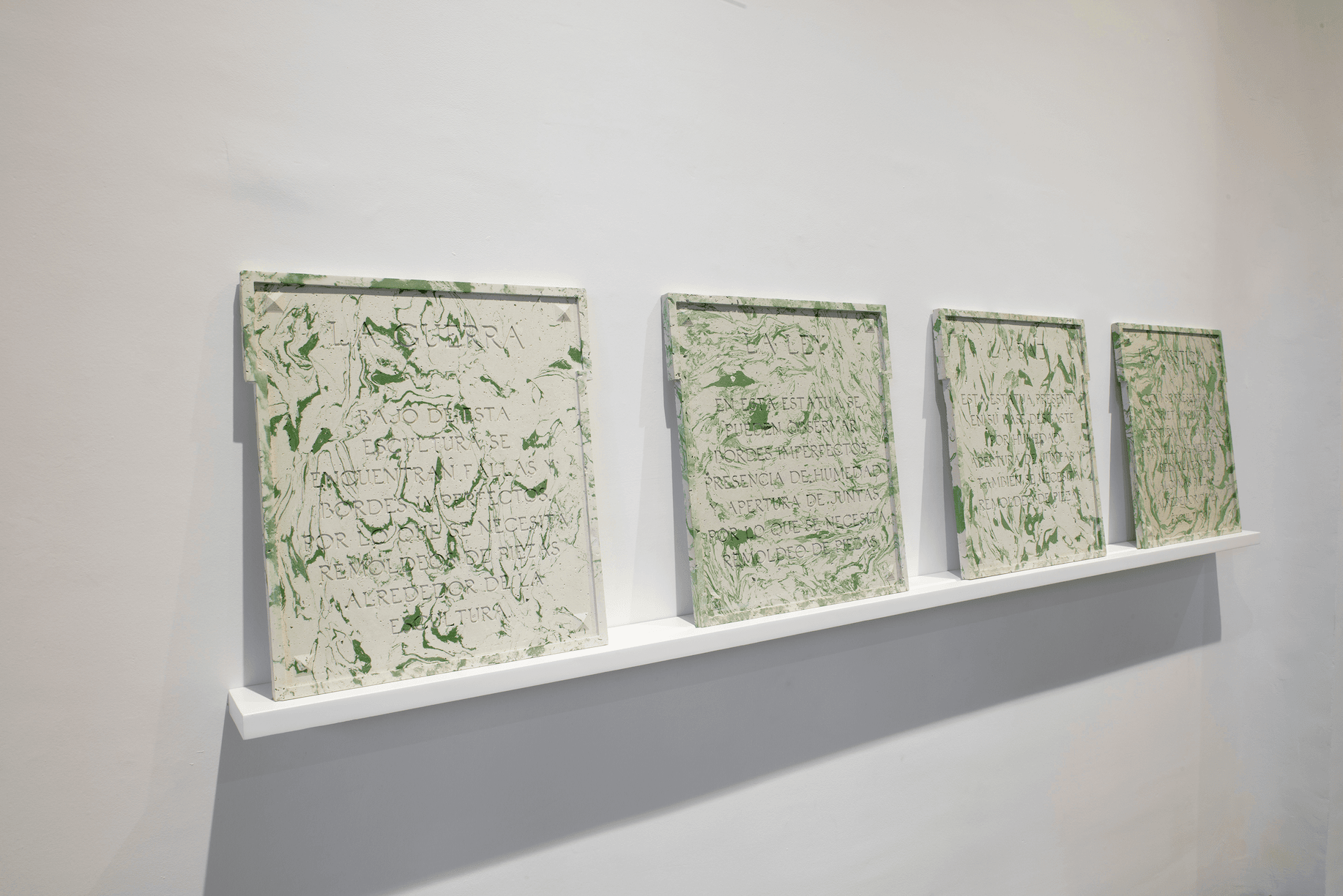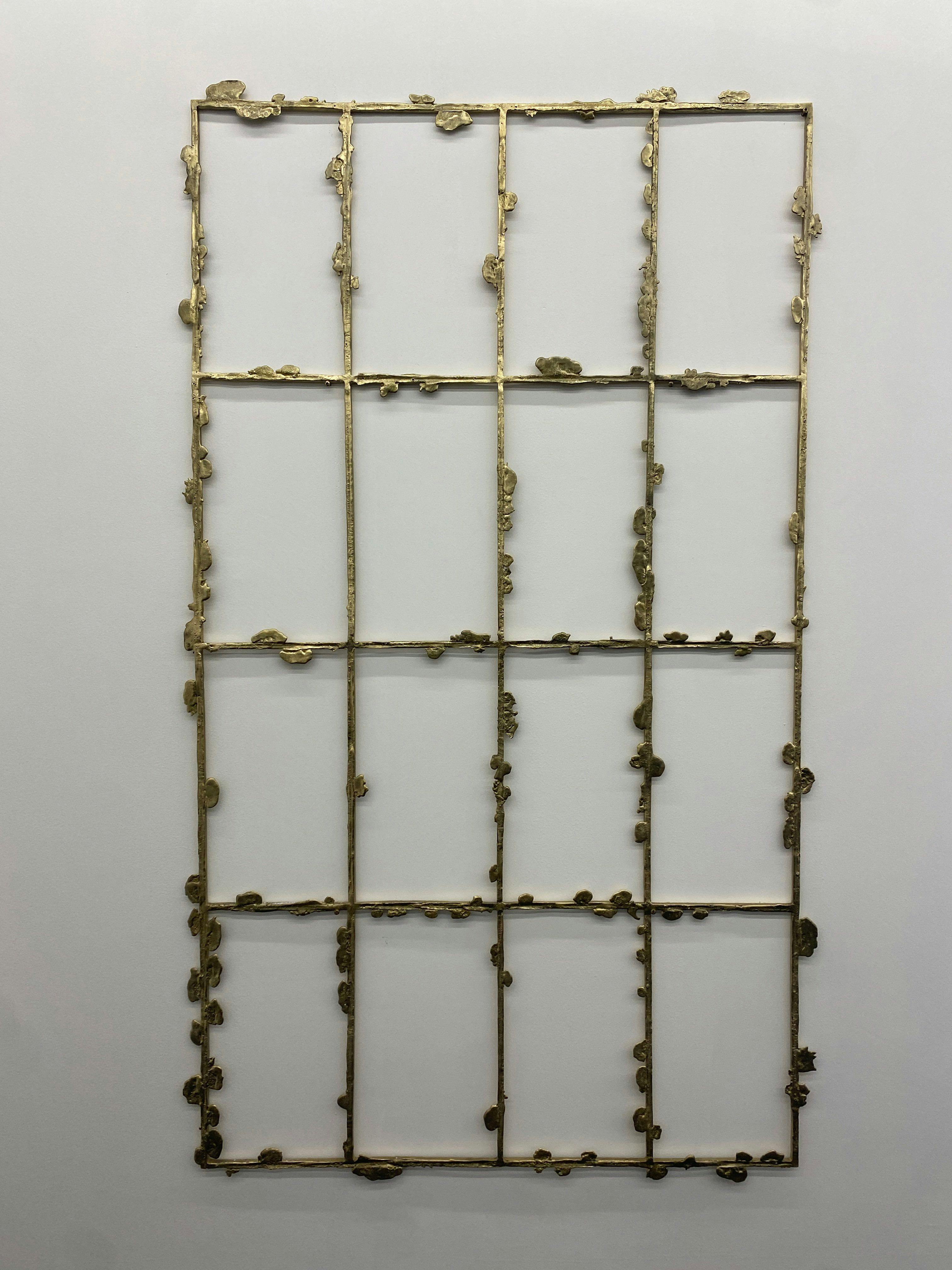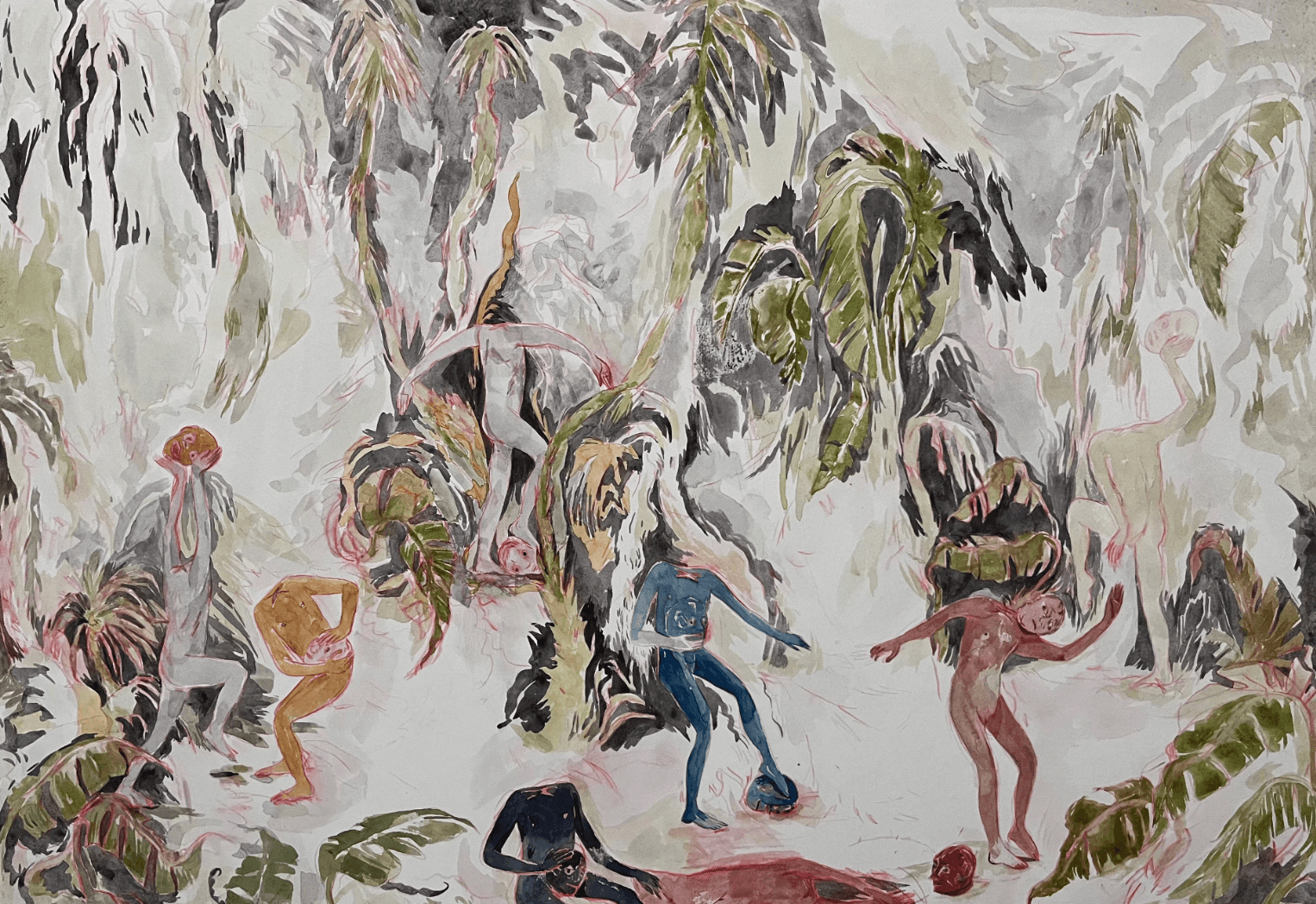AQ.0011
Feria Material:
Material Art Fair 2023
4 select acquisitions
•
Acquired Feb 2023
Feria Material
The Material Art Fair in Mexico City, first founded in 2013, is one of the premier art fairs in Latin America, exhibiting a global range of artists and galleries. In 2023, the ninth edition of the fair welcomes over 70 exhibitors from more than 20 countries. The fair takes place at Expo Reforma, centrally located in Mexico City’s Juarez neighborhood, from Thursday, February 9th to Sunday, February 12th, 2023. For this acquisition round, Arkive curators focused on emerging Latin American artists who speak to our curatorial theme, Making the Invisible Visible.
Arkive members tuned into a live preview walkthrough of the fair on Thursday, February 9th, meeting the gallerists and artists considered for the round. After a series of votes, the community selected Julieta Gil's Ley, Paz, Guerra, Justicia (2021), Tania Pérez Córdova's Untitled (2021), Héctor Jiménez's Dionisios (2020), and Ignacio Gatica's Preface to an Automated Stratosphere (small version) (2022). Core team members then worked with Campeche Galería, Galerie Art Concept, Galerie Nordenhake, and EMBAJADA to acquire the works. The works will go on display via long-term residency at a prominent public location, as selected by the Arkive membership.
Overview
Acquired Works
Julieta Gil's Ley, Paz, Guerra, Justicia (2021)

Plaster, pigments, 40 x 44 x 1 cm
Gil’s interest in age-old restoration processes stems from the continual observation of monuments being cleaned, reconstructed, and repaired in the aftermath of events caused by social turmoil. For instance, the iconic Ángel de la Independencia—officially titled La Victoria Alada—was emphatically graffitied during a 500-person protest in August 2019, in an effort to demand government officials to declare an alert of gender violence. The landmark then was left with phrases like “Mexico feminicida” and “se va a caer” in neon pink, lime green, purple, and black spray paint. Within hours, workers erected a wooden wall around the base of the monument and began power-washing the graffiti. The fast-tracked and inevitable rehabilitation provoked the artist to question, “Why does it need to be repaired? Why can’t it be left exposing the real problems affecting our country?”
This work is a set of faux marble plaques created using an ancient process called 'scagliola.' Each one of them is titled: La Ley (Law), La Paz (Peace), La Guerra (War), and La Justicia (Justice), referencing the four corner pieces in La Victoria Alada; and displays text sourced from newspaper clippings that use bureaucratic language to describe the process of repairing these four pillars. Which led the artist to question, “Is it the statues that need restoration or is it the system itself?”
The actual text from the clipping is set on each plaque is so ironic and translates as follows:
Peace: This statue shows wear at its base due to humidity, opening of joints and also requires remodeling of parts.
Justice: Here there are cracks, opening of joints and for this, replacement of some parts around the sculpture is needed.
Law: In this statue you can see imperfect edges, the presence of moisture and the opening of joints, which is why it is necessary to reshape the pieces.
War: Under this sculpture there are flaws and imperfect edges, so it is necessary to reshape parts around the sculpture.
Introducing Julieta Gil
Julieta Gil (born 1987, Mexico City, Mexico) creates work from an in-depth analysis of how power structures materialize as symbols that occupy public space. Experimenting with digital and analog media, her process originates from routine walks and participation in public protests around her native Mexico City, thoroughly documenting public architecture, monuments and statues. Gil’s record-keeping system consists of photogrammetric scanning procedures that are traditionally used to create 3D models as simulations of physical objects. Gil devises methodologies that register and catalog her bodily interaction with these, reconfigures and materializes them in ways that put the very idea of the archive into question. Gil’s practice spans installation, sculpture, 3D renderings and time-based media, and incorporates themes of feminism, fiction, memory, and technology with a focus on confronting hegemonic and exclusionary narratives.
In 2020, Gil received the Lumen Prize for Art and Technology for her project “Nuestra Victoria”, envisioned as a response to government censorship around a prominent Mexico City monument which served as a site of protest and intervention by feminist groups. She has exhibited at Nevada Museum of Art, Palm Spring Art Museum, SCAD Museum of Art, Storefront for Art and Architecture, Museo Tamayo, Laboratorio de arte Alameda, Centro de Cultura Digital, among other institutions. She is currently Art & Tech Visiting Assistant Professor within the Department of Art at the University of Oregon.
Tania Pérez Córdova's Untitled (2021)

Bronze poured into sand, 127 × 218 × 2 cm
From the gallery: "She sometimes describes her sculptures as stage props of a script about everyday life. They are performative works that do not move—“contemporary relics,” as she calls them. Although perhaps, “contemporary fossils” is more adequate—they are objects that witness life happening around them and slowly, almost as if suggesting sedimentation, give traces of human life. Perhaps less visible but also very much present in Tania’s work is her interest in materiality. She often tests the physical limits of materials by transforming them into something they’re not: melting a bronze coin with beer cans to the point where the coin is still a coin, reshaping an old car’s windshield into an ornament, or pressing a piece of foam to suggest an action. One could speak of the "Contour" series in the same way. In sand, bronze and aluminum from canned beverages are cast into an impression in the shape of an existing window."
From Tania: “I feel making work is a process of looping between the general and the personal. Climate change anxiety, political tensions, migration issues, gender politics, violence are all issues that reflect on everyday life and translate into our way of living and our rendering of the world. It is unavoidable for me to speak about these issues, but I try to address them as a personal experience, from the intimacy of everyday life.”
Introducing Tania Pérez Córdova
Tania Pérez Córdova (b. 1979) is a Mexican artist born in Mexico City where she lives and works. After studying at the school of Fine Arts in Mexico City, she went on to get a BA in Fine Art at Goldsmiths College in London. Her work has been shown in solo exhibitions at Kunsthalle Basel (2018), the Museum of Contemporary Art in Chicago (2017) and soon at Tamayo Museum in Mexico City (October, 2022). Her work is part of important public collections such as Museum of Contemporary Art Chicago/US, Tamayo Museum/MEX, Jumex Collection/MEX, San Francisco Moma/US, Cisneros Collection/US-VEN, Museo Amparo/MEX.
Héctor Jiménez's Dionisios (2020)

Watercolor on paper, 41 x 59 cm
From Residency Unlimited: "Héctor Jiménez Castillo’s practice is influenced by intuition, chance and the use of his own biography. His work frequently depicts human vulnerability and examines identity and intimacy. Castillo investigates the production of images that are inspired by our unconscious and explores them in different media including choreography, text, drawing, and sculpture. His work process can be described as methodically organizing an unveiling of his own reality and that of others while playing with notions of chance. Castillo actively collaborates with theater companies such as Optional Company and the Teatro Ojo collective."
Introducing Héctor Jiménez
Héctor Jiménez works and lives in Guadalajara, Jalisco, MX. Through his work he analyzes the production of images that appeal to the subconscious exploring different media such as drawing, choreography, writing, costume design and sculpture. He’s interested in artistic production as a means of getting to know places, people and having extraordinary experiences. With a particular interest in the performing arts, Jiménez works and collaborates with dance, theater and cinema projects. He’s a co-founder and active member of the art lab Arrogante Albino whose work could be considered a college of media around the body as a theme. He has collaborated with Alexander Mendicuti (ES), Compañía Opcional (MX - ES), Lara Ortíz (ES), Tamara Cubas (UY), Teatro Ojo (Mx), Heesoo Agnes Kim (KR).
Ignacio Gatica's Preface to an Automated Stratosphere (small version) (2022)

LED screens, aluminium and steel frame, 3 x 14 x 3 in
In the digital sculptures Preface to an automated stratosphere, Chilean artist Ignacio Gatica predicts the national debts of various countries that the World Bank categorizes as “low-” and “middle-“ income. Appropriating the form of a stock ticker, the work forecasts numbers generated by Gatica using popular econometric algorithm models such as ARMA (auto-regressive moving average). Subverting the sleek technological architecture and aesthetics that are often used to display information for private companies, Gatica instead warns of increasing economic disparities across the globe.
Introducing Ignacio Gatica
Ignacio Gatica (Chilean, b. 1988) currently lives and works in Brooklyn, New York. Gatica works in installation, sculpture, video, and text to question systems of knowledge that configure personal and collective experiences. Concerned from an analytical standpoint with the experience of urban living, Gatica’s work modifies the elements that construct these socio-political spaces, merging data, materials, and theoretical frameworks to reconfigure particular views. Gatica has exhibited at SculptureCenter (Queens, NY); the Hessel Museum of Art at CCS Bard (Annandale-on-Hudson, NY); El Museo del Barrio (Manhattan, NY); Galeria Jaqueline Martins (São Paulo, Brazil); Galeria Gabriela Mistral (Santiago Chile); Fondation Hippocrène (Paris, France); and Fundación Marso (Mexico City, Mexico), among others.
The works
Select Member Comments
Conversation
Additional Materials
We encourage you to read further into Material Art Fair, our selected artists and their works, and the Mexico City art scene. As always, this is just the start. Apply to Arkive to continue the conversation with the community.
